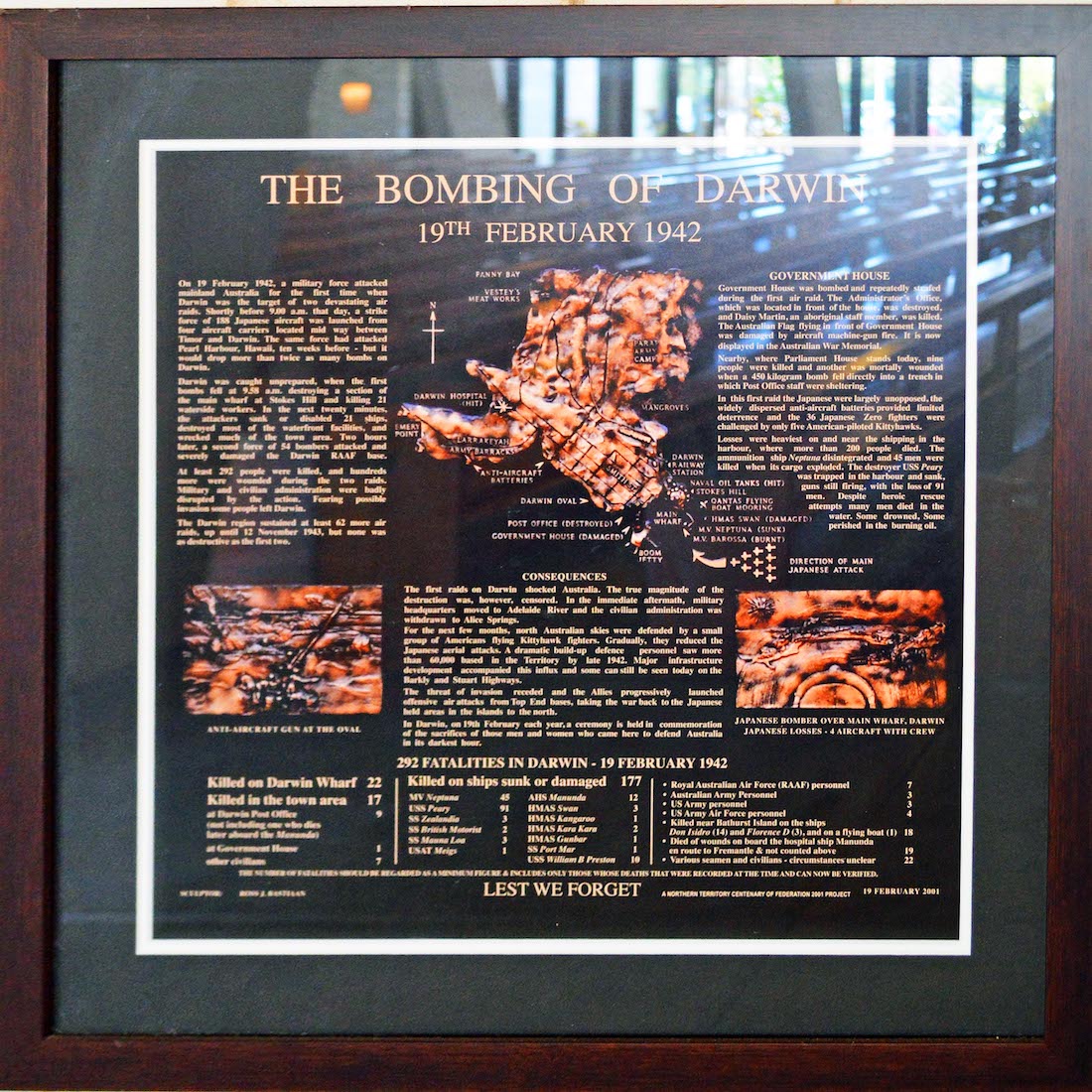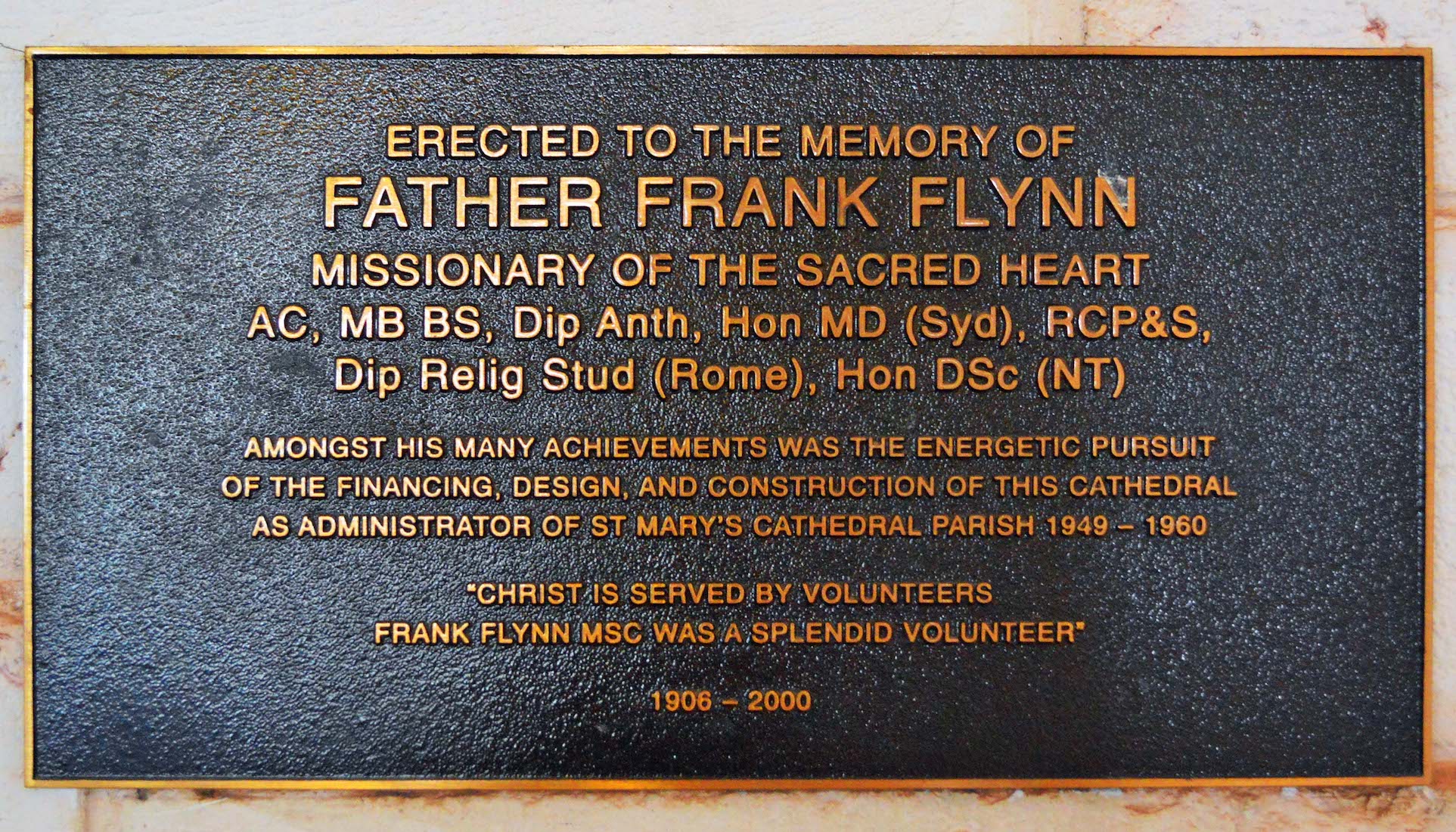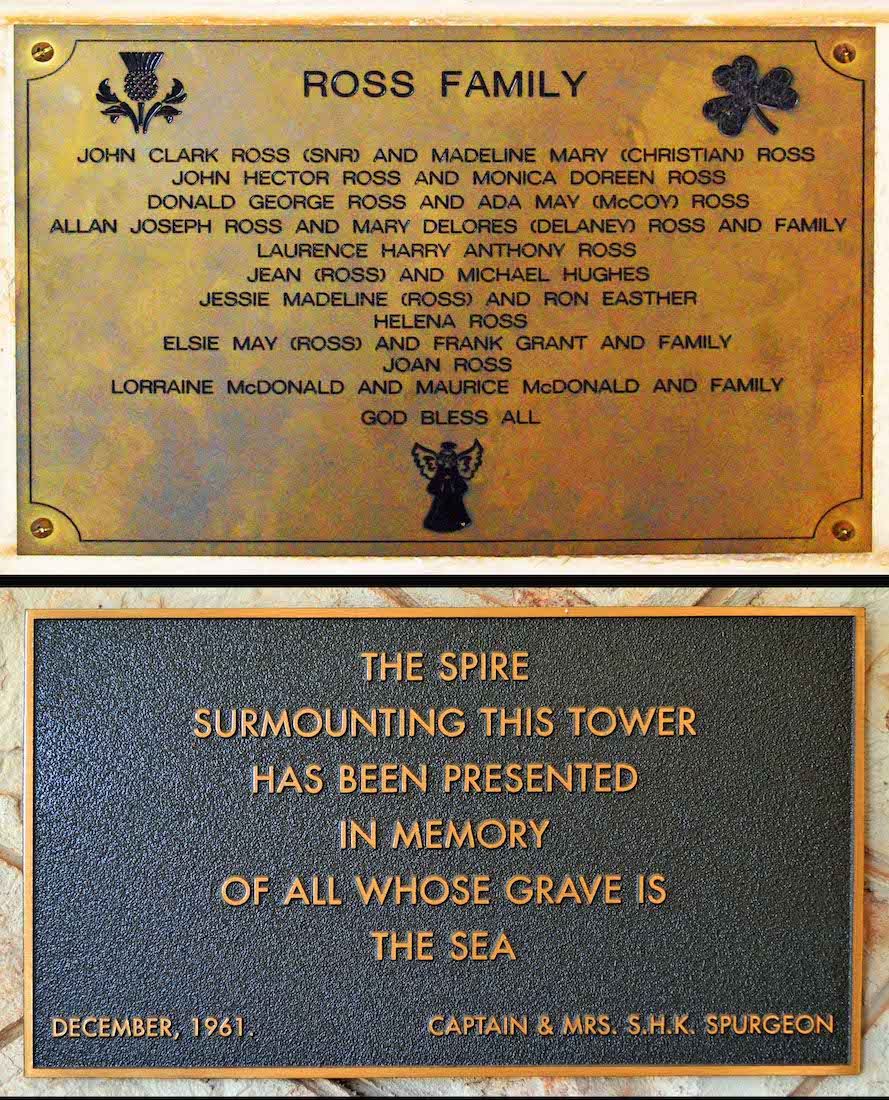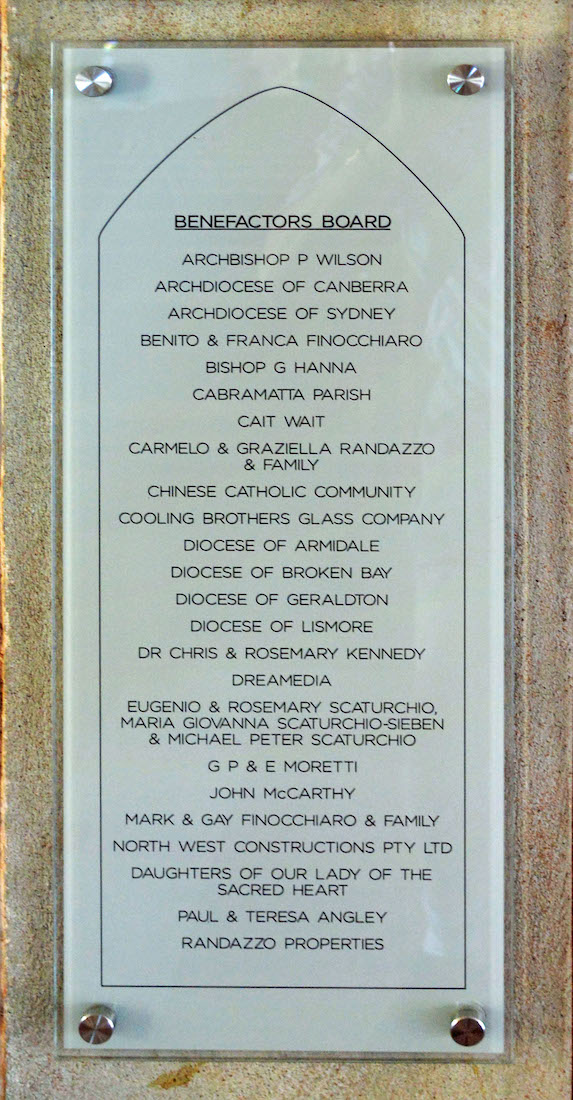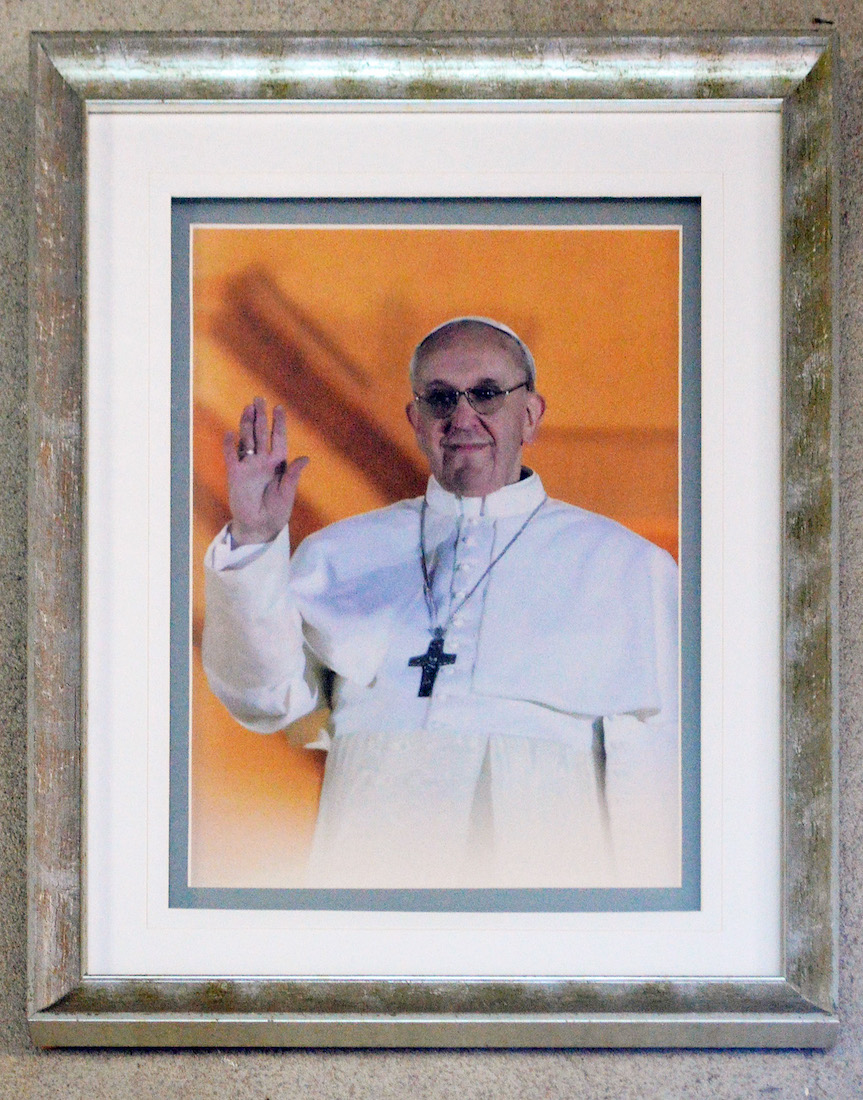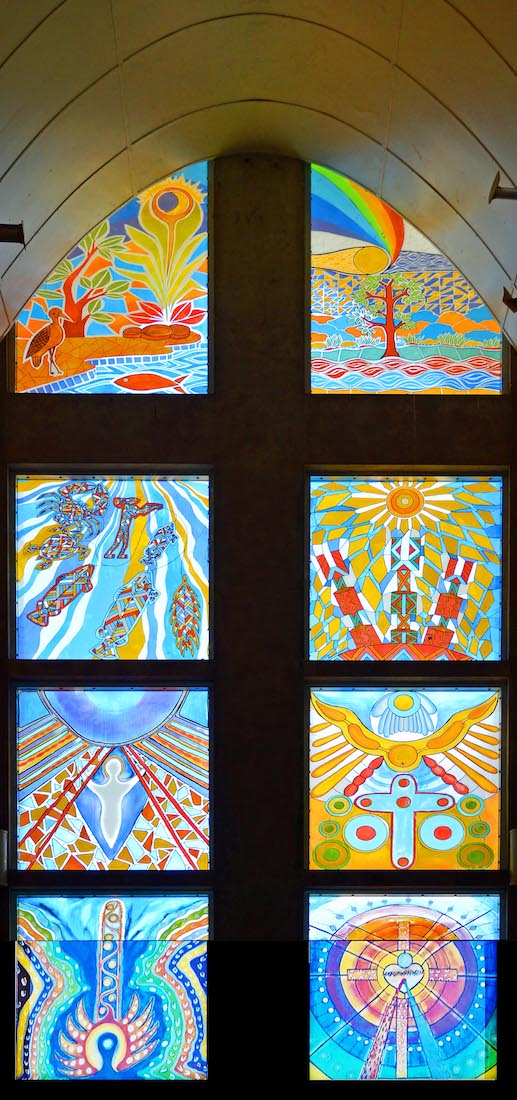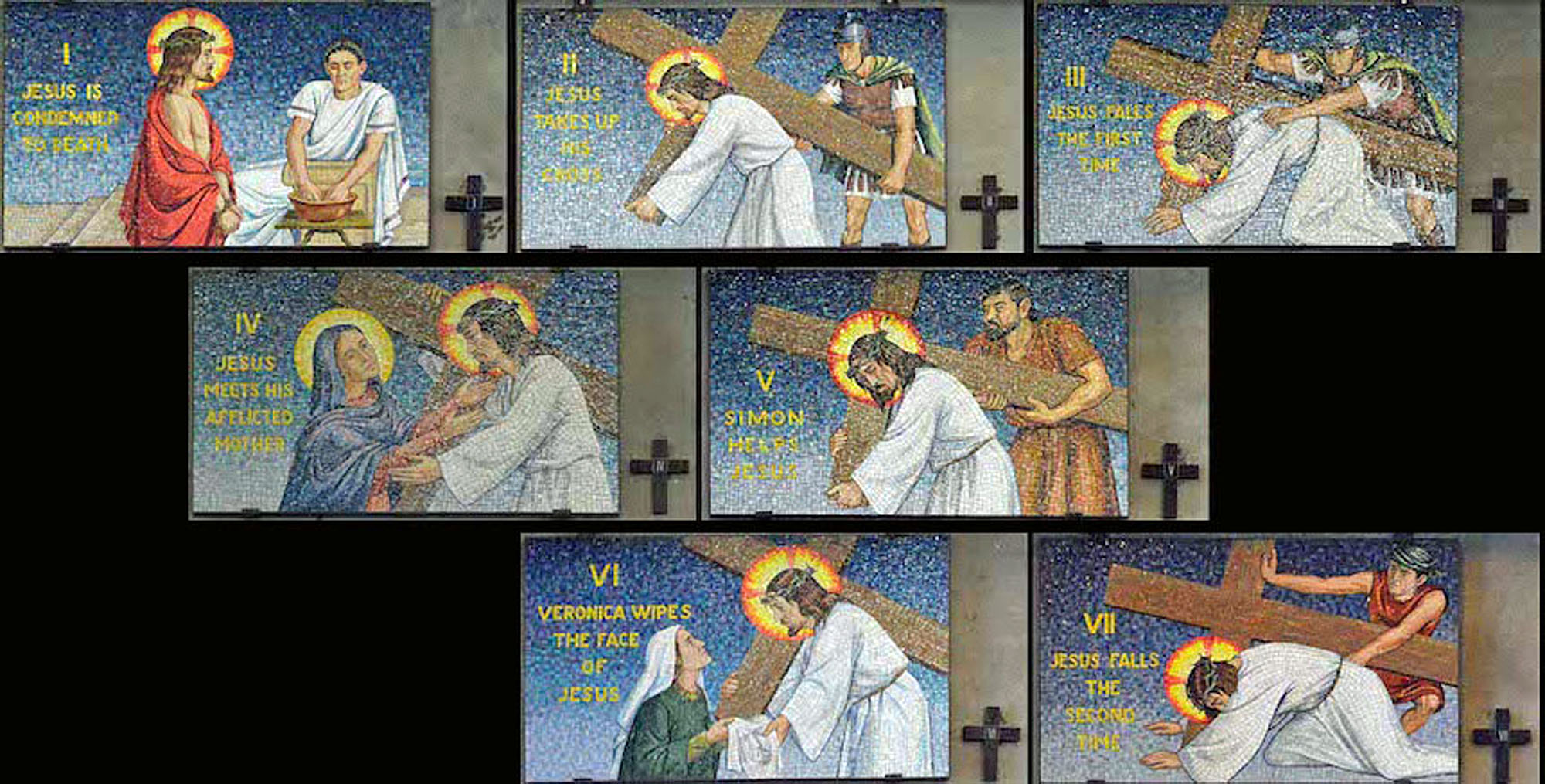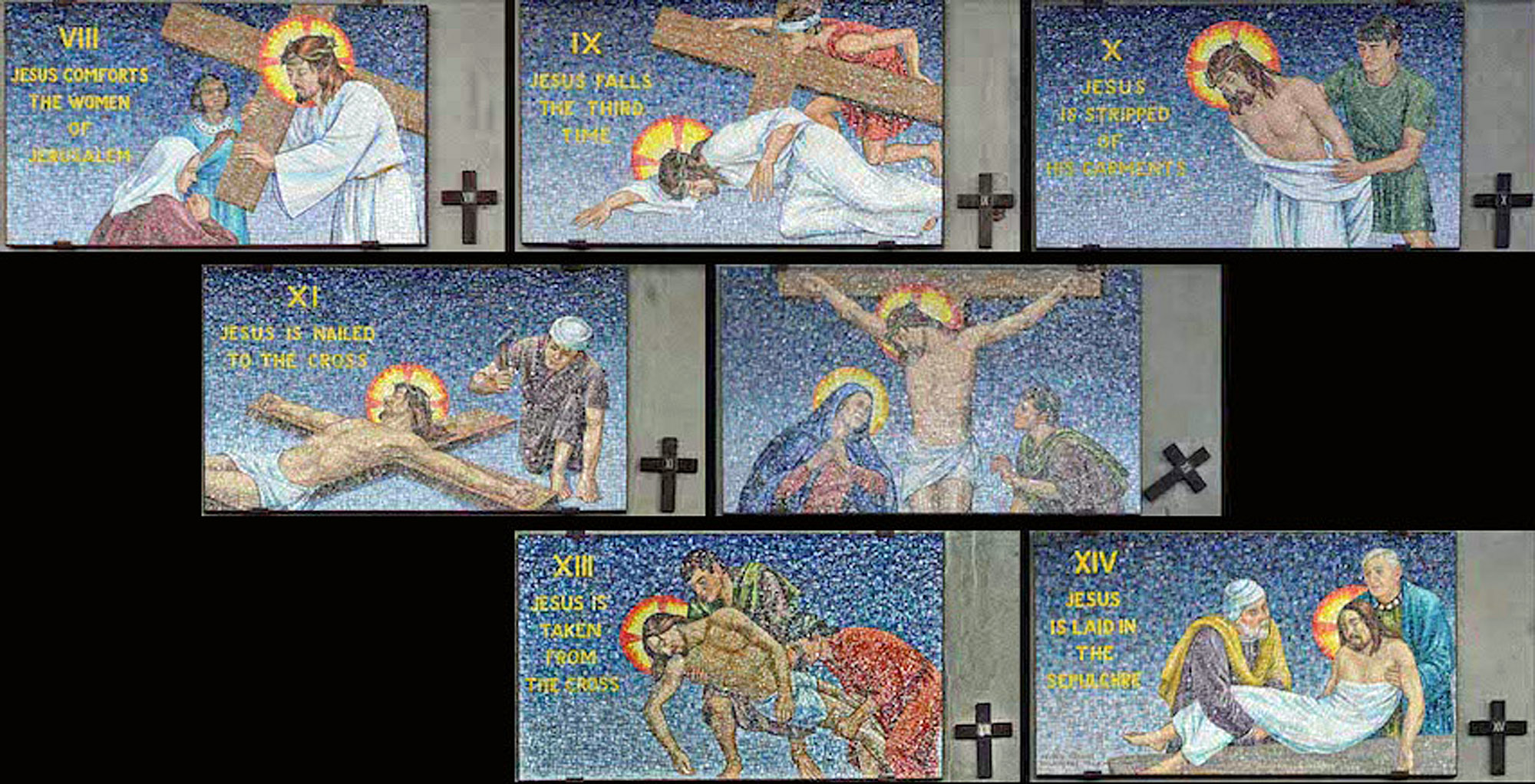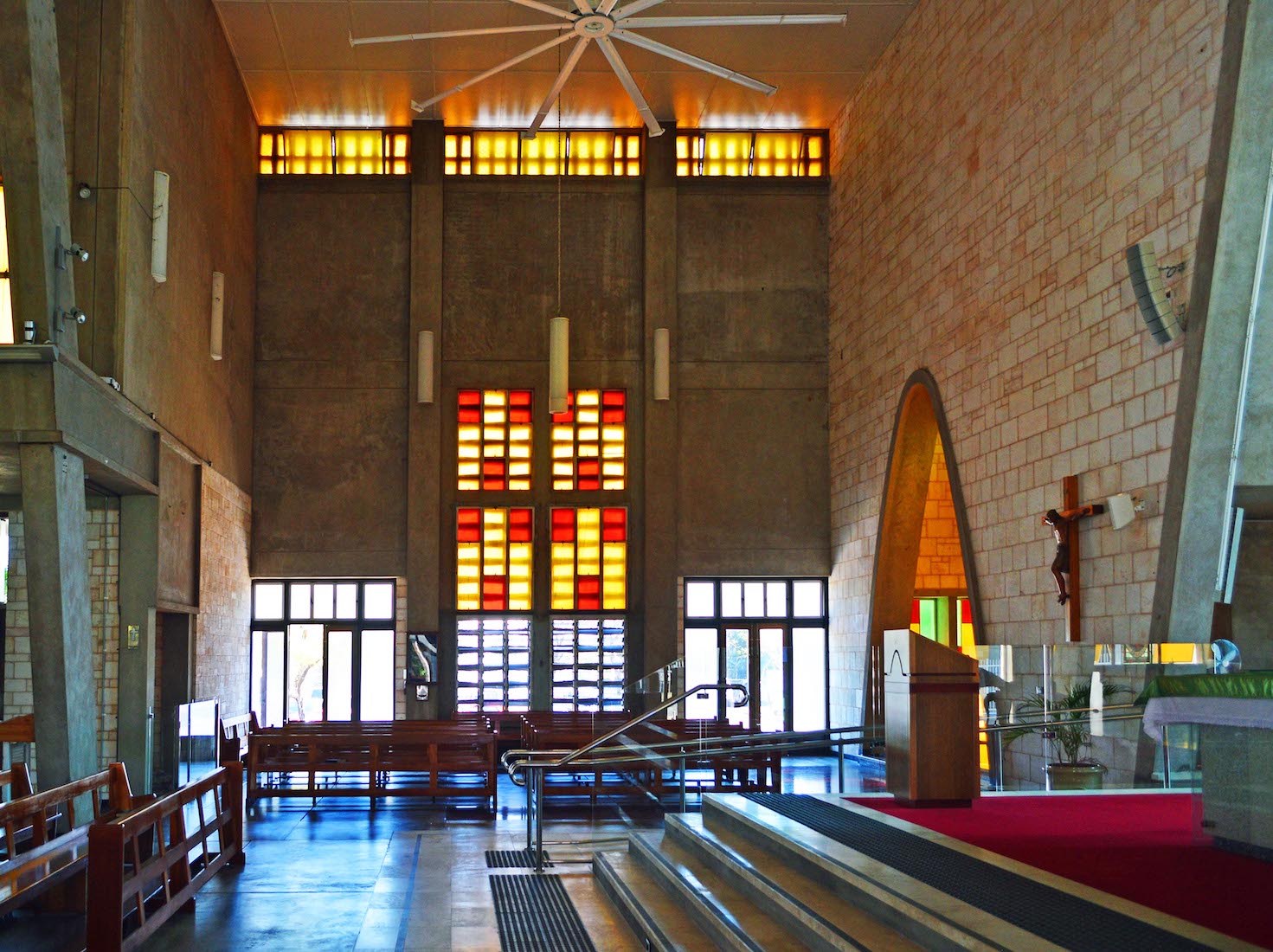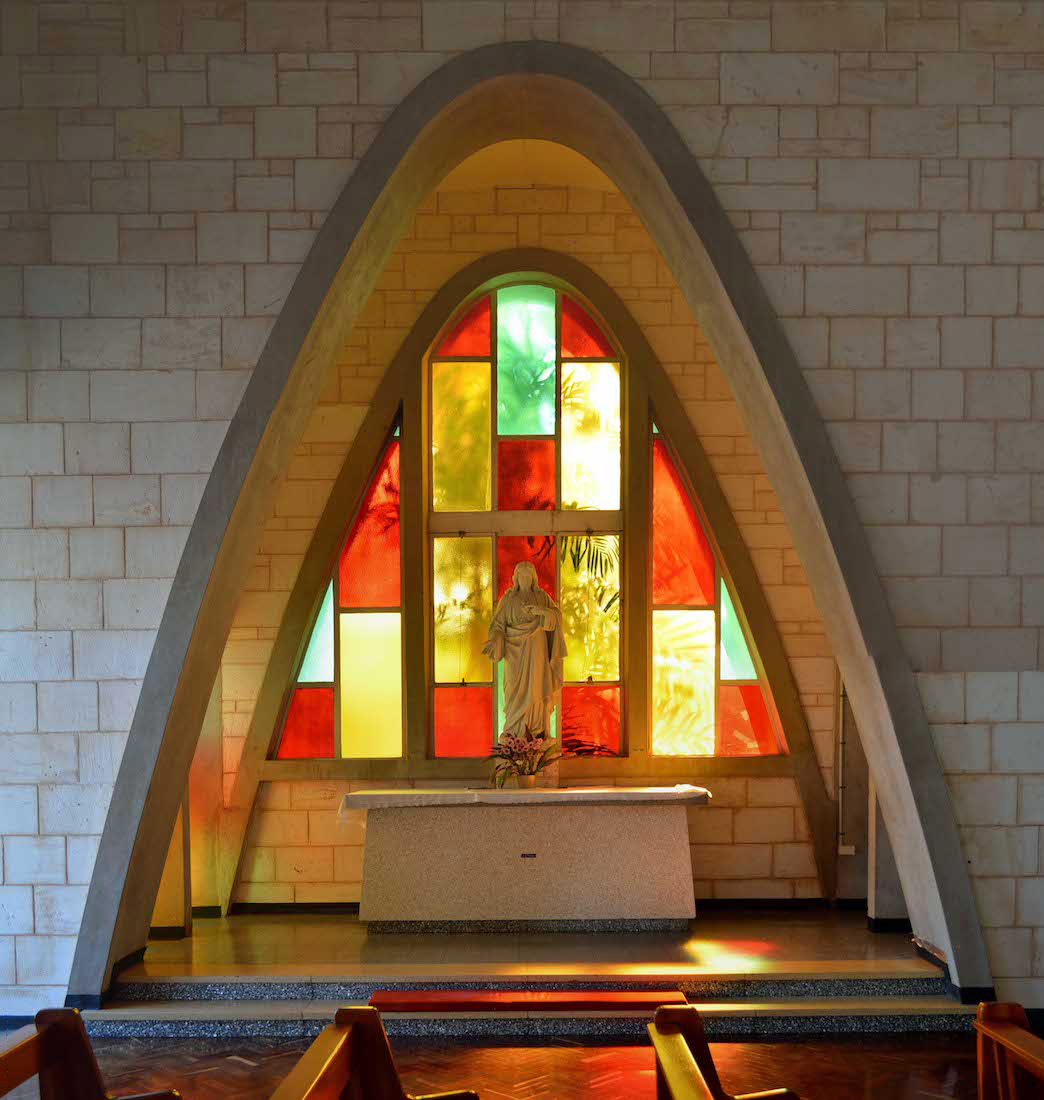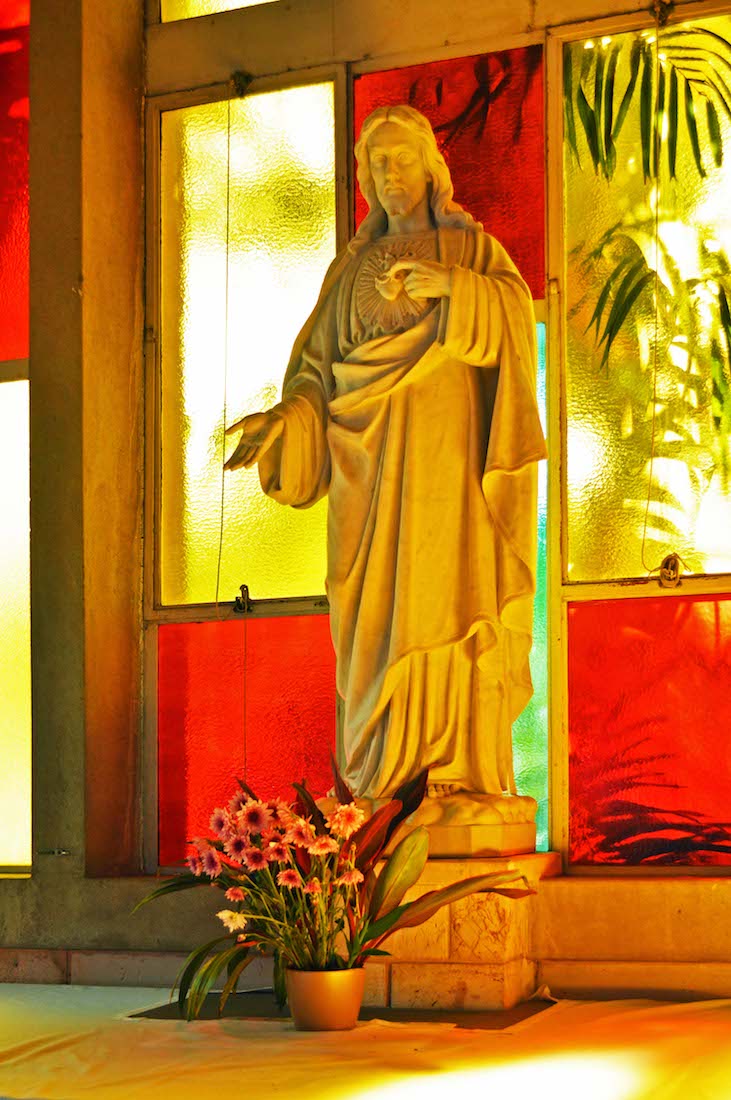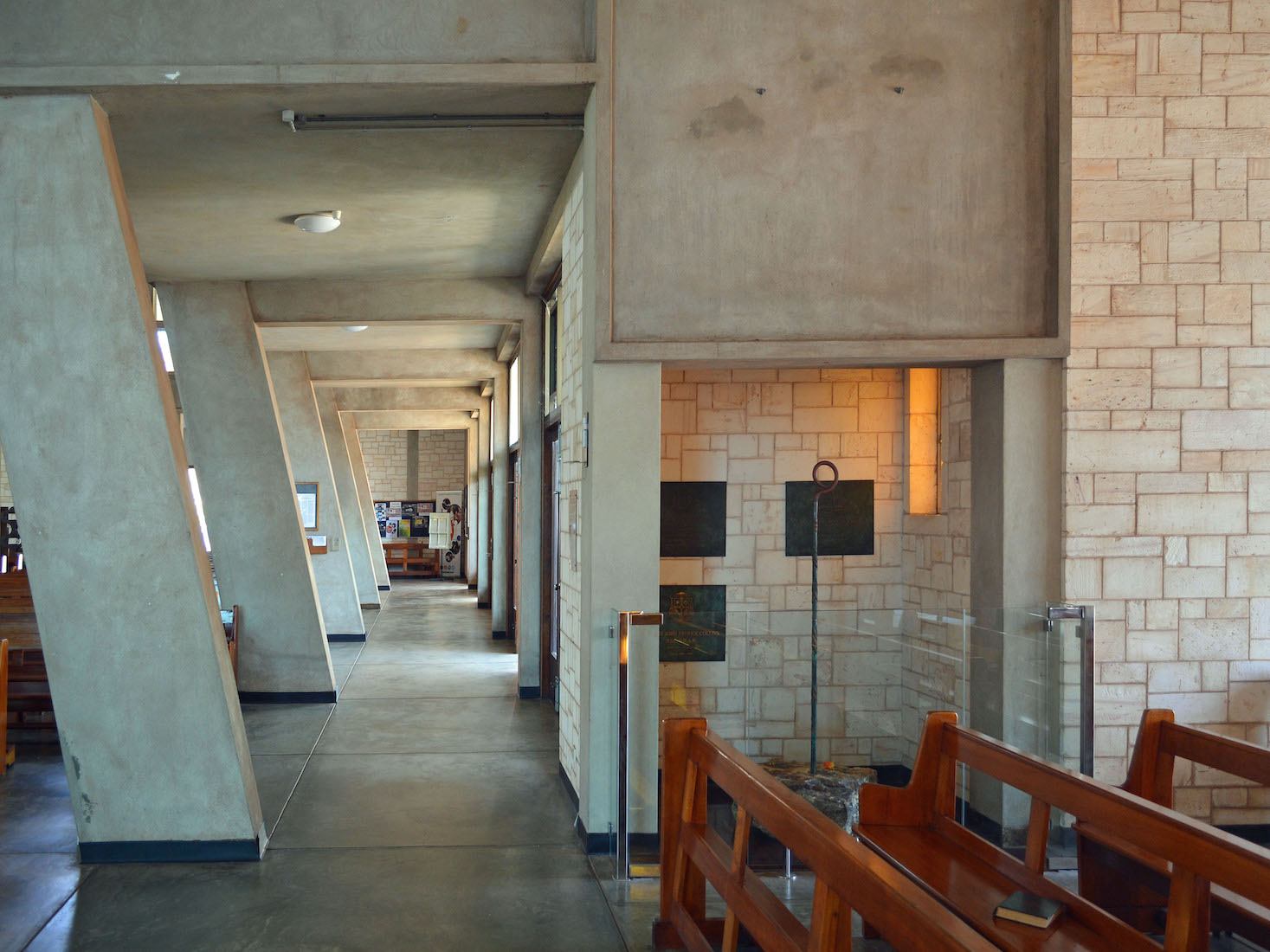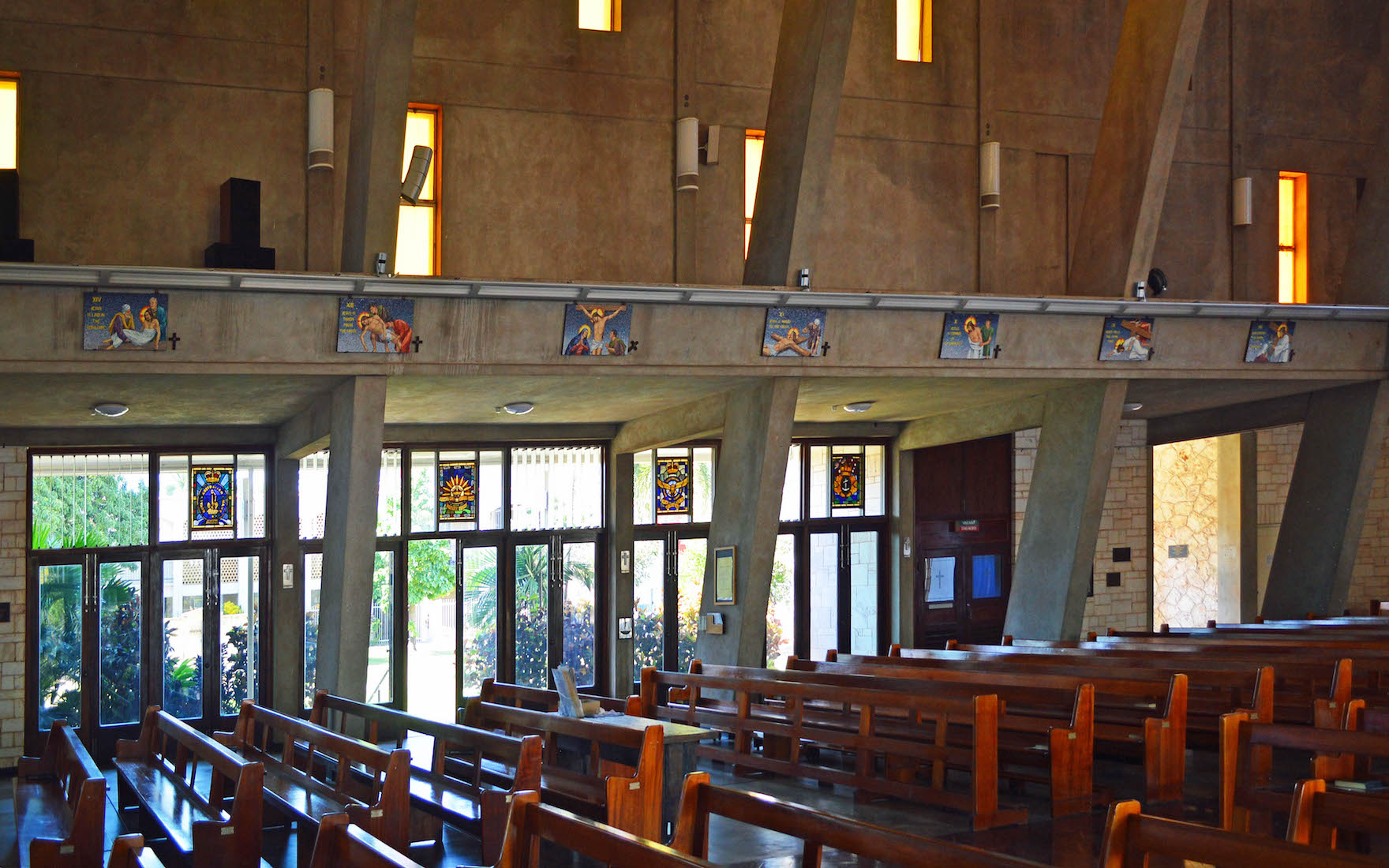
The South nave wall is very similar to the North nave wall. Glass doors open out to a garden area, there are four memorial stained glass panels in the strip above the doors, and above this are seven Stations of the Cross. There are two plaques to the left of the doors, and further plaques to the right. INDEX
22. ARCHITECT AND BUILDER
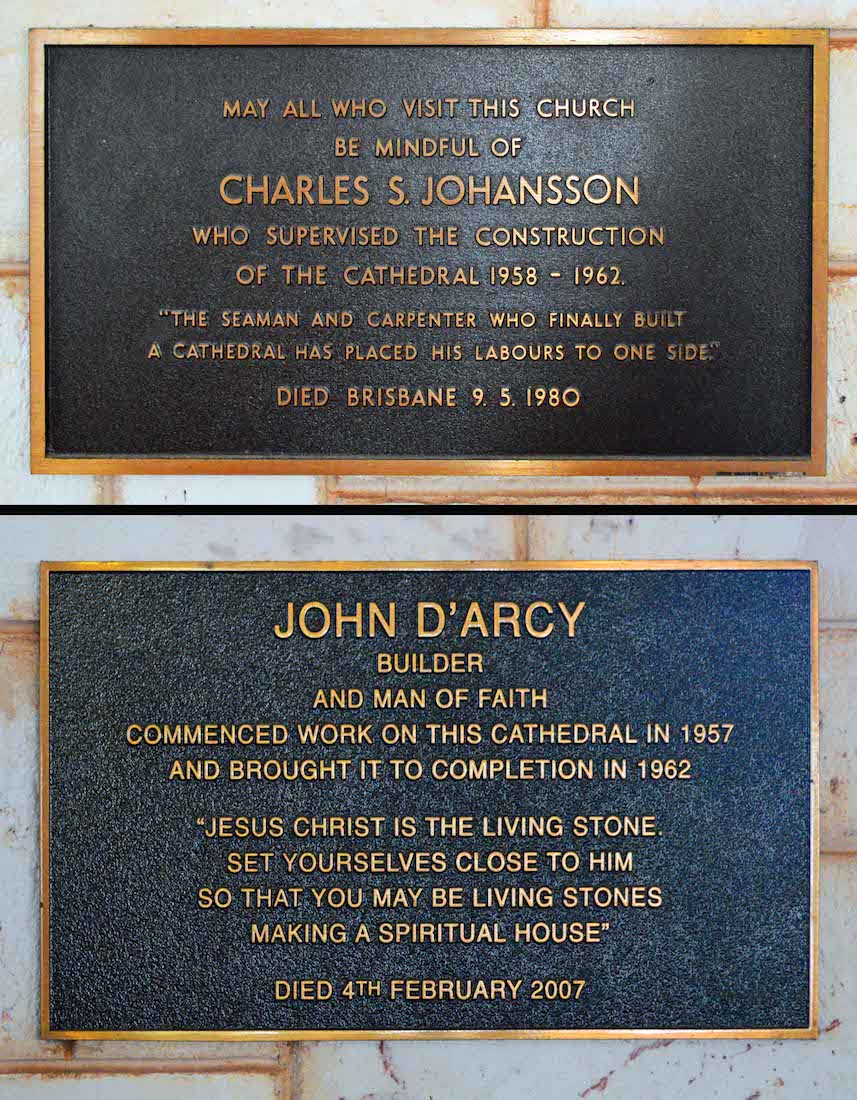
The architect of the Cathedral was Charles S Johannson, who supervised the construction of the Cathedral 1958 – 1962. The builder was John D’Arcy who died in 2007.
23. SOUTH MEMORIAL WINDOWS
These Memorial Windows commemorate (from left) the service of: the Royal Australian Navy, the Australian Commonwealth Military Forces, and the Royal Australian Air Force. The final window has no specification, but has a distinctly Naval theme.
24. BY THE SOUTHWEST DOOR
By the Southwest door there are a number of plaques and a large framed poster.
25. THE BOMBING OF DARWIN
Two relatively recent events have shaped Darwin. The more recent event was Cyclone Tracy in 1974, but before that, Darwin experienced bombing raids by the Japanese in WWII. Surprisingly, the number of bombs dropped was greater than the number dropped on Pearl Harbour. There were 292 Darwin fatalities. At the time, the rest of Australia knew little of these events due to Government censorship.
26. FRANK FLYNN MEMORIAL
This plaque commemorates the life of Father Frank Flynn, Missionary of the Sacred Heart, who played an important role in the early life of this Cathedral. Francis Stanislaus Flynn (Frank) lived 1906 – 2000. He sought to combine his vocations of priest and ophthalmologist, saying, ‘I have been fortunate, indeed, in that wherever I have gone I have found a union of two interests, one aimed at healing the body and the other aimed at healing the spirit'. There appears to be no connection with the other famous Flynn of Central Australia – John Flynn of the Flying Doctor Service.
27. DOORWAY PLAQUES
The top plaque commemorates the many members of the Ross family. Presumably this family were very much involved in the ministry of the Cathedral. The lower 1961 plaque tells that the Cathedral spire is in memory of all those who died at sea. The perils of the sea are an on-going concern to sea-faring peoples, whether it be in war, fishing, or just pleasure.
28. ST JOSEPH
This statue of St Joseph is tucked away round the corner in the Southwestern porch. Joseph is often recognizable by the sprig of lilies he holds. This relates to an old legend in which it was revealed that the Saviour would be born to the family of the young man whose staff sprouted.
29. WEST WALL BENEFACTORS LIST
This is a list of people and organizations that have made significant contributions to the building and upkeep of the Cathedral.
30. WEST WINDOW POSTER
This poster is a fine illustration of the Bishop O’Loughlin (West) Memorial Window. Bishop O’Loughlin opened the Cathedral in 1962. The Catholic connection to the Indigenous communities of the Northern Territory dates back to the mid 1850’s, when missionaries first visited the region’s remote areas. The church has since forged a strong relationship with the Indigenous people, and a small Catholic church in the remote Santa Teresa (Arrernte) community is credited with inspiring the artwork behind this window, which was undertaken in memory of the late John O’Loughlin, a bishop of Darwin for more than 30 years.
31. POPE FRANCIS
Above the West door is a familiar photograph. Pope Francis, born 17 December 1936, is the 266th and current (2020) Pope of the Roman Catholic Church, a title he holds ex officio as Bishop of Rome, and Sovereign of the Vatican City. He chose Francis as his papal name in honor of Saint Francis of Assisi. Francis is the first Jesuit Pope, the first from the Americas, the first from the Southern Hemisphere and the first non-European Pope since the Syrian Gregory III, who died in 741.
32. CONSECRATION CROSS
These simple consecration crosses appear in various places all around the Cathedral. The crosses show where the bishop has anointed the Cathedral with chrism or holy water in order to consecrate it.
33. WEST WINDOW
The view of the bottom panels of the Bishop O’Loughlin Window from the Cathedral is blocked by the balcony wall. So a little cheating has taken place here! The top right panel is by artist Cilla Kurrupuwu, and is about the creation story. The central bloodwood tree represents Jesus’ cross and is used to make the ceremonial Pukumani pole in Tiwi culture. The red and blue beneath the tree illustrate the blood and water which flowed from Jesus’ side. The rainbow is included in the design to represent light. It is the sunlight which gives us the beautiful rainbow colours ... and God is the Light of the World.
34. STATIONS OF THE CROSS – SOUTH
The Stations of the Cross, which adorn the nave of the Cathedral, were executed at Spilimbergo, Italy, in Venetian mosaic, according to drawings made by Miss Lola McCausland of Brisbane. The stations were erected by parishioner subscription. The first seven Stations are: I. Jesus Is Condemned To Death; II. Jesus Is Made To Carry His Cross; III. Jesus Falls The First Time; IV. Jesus Meets His Sorrowful Mother; V. Simon Of Cyrene Helps Jesus Carry His Cross; VI. Veronica Wipes The Face Of Jesus; VII. Jesus Falls The Second Time.
35. STATIONS OF THE CROSS – NORTH
The remaining Stations are: VIII. The Women Of Jerusalem Weep Over Jesus (the woman in the centre is depicted as an Aboriginal girl); IX. Jesus Falls The Third Time; X. Jesus Is Stripped Of His Garments; XI. Jesus Is Nailed To The Cross; XII. Jesus Is Raised Upon The Cross And Dies; XIII. Jesus Taken Down From The Cross And Placed In The Arms Of His Mother; XIV. Jesus Is Laid In The Sepulchre (the figure at the right is rendered in the likeness of Fr W. M. Henschke in whose honour the Stations were erected).
37. NORTH TRANSEPT CRUCIFIX
The death of Christ on the Cross is central to Christian and Roman Catholic belief. The letters INRI at the top of the Cross stand for the words: ‘Jesus of Nazarath, King of the Jews’. Protestant Christians tend to prefer the ‘empty Cross’, but there is no denying the historical aspect of the crucified Christ.
39. JESUS OF THE SACRED HEART
The devotion to the Sacred Heart is one of the most widely practiced and well-known Roman Catholic devotions, taking Jesus Christ's physical heart as the representation of His divine love for humanity. The devotion is especially concerned with what the Church deems to be the love and compassion of the heart of Christ towards humanity, and its long suffering. The origin of this devotion in its modern form is derived from a Roman Catholic nun from France, Saint Margaret Mary Alacoque, who said she learned the devotion from Jesus during a series of apparitions to her between 1673 and 1675.
40. BISHOPS’ ALCOVE
On the West side of the North transept is a small alcove containing a bishop’s staff, and four plaques.




